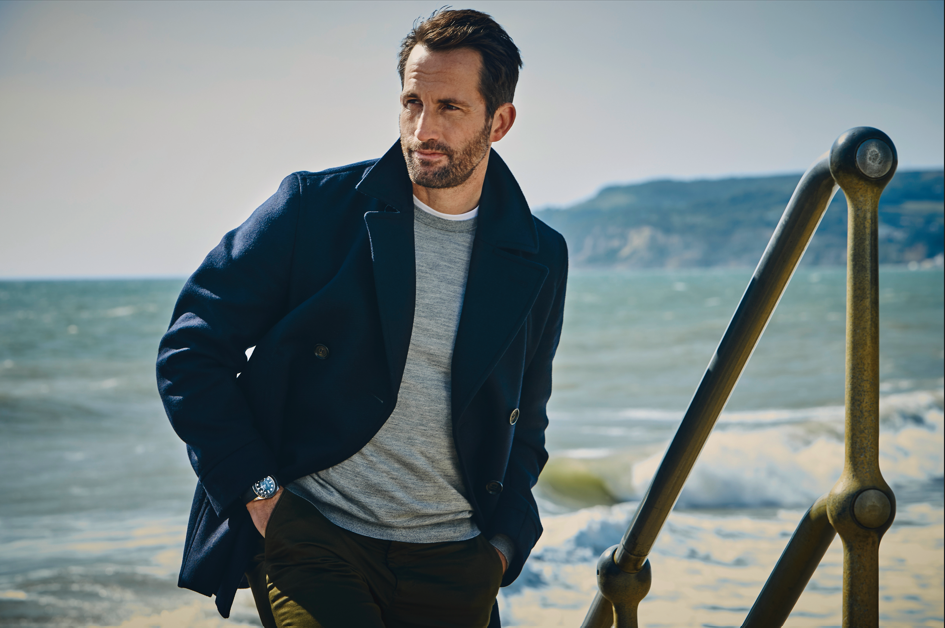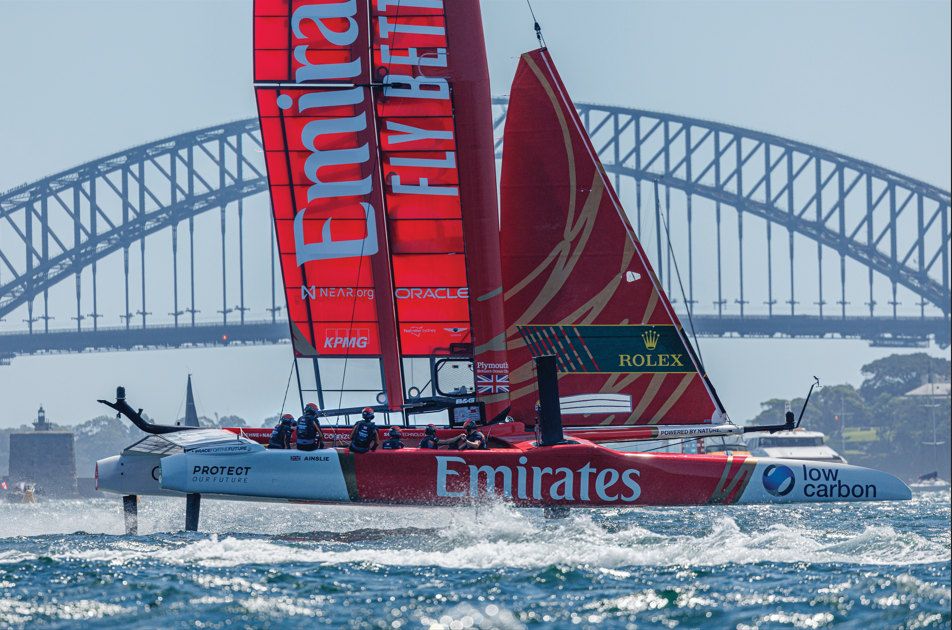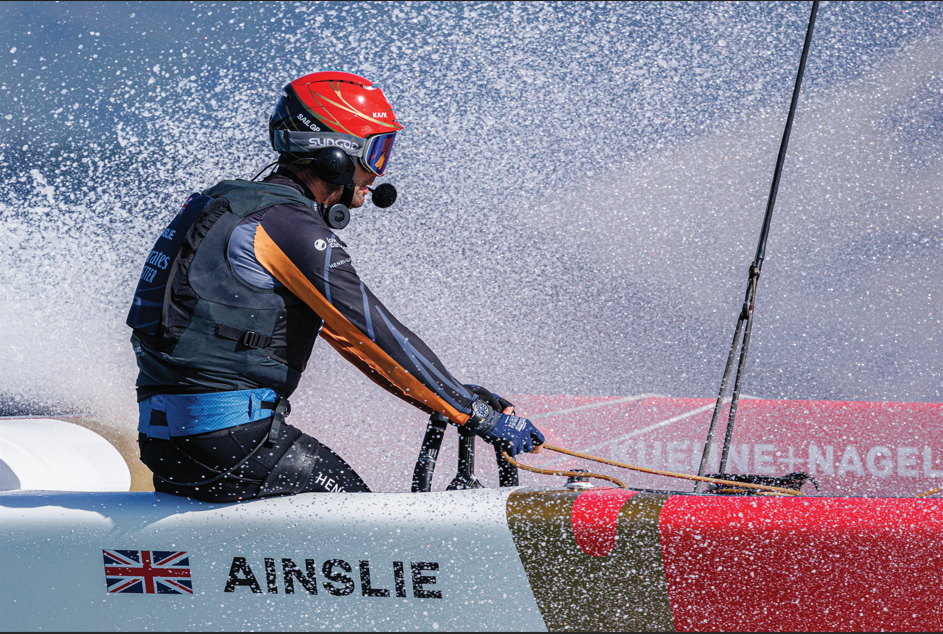Sir Ben Ainslie stands as the most successful Olympic sailor in history, having competed in five consecutive Olympic Games from 1996 to 2012. Throughout his Olympic career, Ainslie clinched four gold medals and one silver, a testament to his unmatched skill and determination. Beyond the Olympics, he has secured an impressive 11 world championship titles in single-handed dinghy and match-racing classes, cementing his legacy as one of sailing's all-time greats.
Ainslie's remarkable achievements have also earned him the prestigious Rolex World Sailor of the Year title a record four times, in 1998, 2002, 2008, and 2012. His sailing prowess extends beyond small boats, as he has also competed in some of the world’s most renowned 600-nautical mile races, including the Rolex Middle Sea Race and the Rolex Sydney Hobart Yacht Race, as well as the annual Maxi Yacht Rolex Cup.
In recognition of his outstanding contributions to the sport, Ainslie joined the family of Rolex Testimonees in 2019, a fitting partnership given his enduring excellence and leadership in the sailing world.
 Sir Ben Ainslie is Chief Executive Officer of Ineos Britannia and The Great Britain SailGP team
Sir Ben Ainslie is Chief Executive Officer of Ineos Britannia and The Great Britain SailGP team
What does it mean to be a Rolex testimonee?
I have been aware of Rolex’s involvement in sailing for many, many years and it is an honour to be involved. Sailing is a technical sport. Precision and excellence are core to the overall performance in sailing from a sporting perspective and this is a common link with what Rolex stands for.
Even with just sailing there are some real legends of the sport involved in the Rolex Testimonee family: Paul Elvstrom, most notably. From my Olympic background and as a child growing up he was very much a hero and icon of the sport. Paul Cayard has achieved a huge amount and when I was making the transition from Olympic sailing to the America’s Cup, Paul gave me a lot of advice early on and was an early mentor in terms of my professional sailing. For many of us, he is a great example of how one should be. I have some great history racing against Robert Scheidt. It was some of the most intense competition of my career and so I have a huge amount of respect for him too.
And that’s just sailing. In sport in general, there are the likes of Roger Federer and Tiger Woods; guys who I look up to as the most amazing sportsmen in their particular fields.
When did you get your first Rolex?
The first Rolex I received was for winning the 2002 Rolex World Sailor of the Year Awards. I was fortunate enough to win this award on four occasions, in 1996 before Rolex came on board, and then in 2002, 2008 and 2012. All great moments in my career and to receive a Rolex with its nearly 70 years of history in the sport is something very special.
What is your favourite Rolex watch? What do you like the most in terms of functionality and practicality of this watch?
While I find the Deep Sea to be a seriously impressive piece of engineering, my favourite Rolex is the Sky Dweller in terms of the look, feel, and functionality. It is quite suited to my lifestyle, moving about the world so much.
From a sailor’s perspective, the Yacht-Master II is another exceptional timepiece. To know that I could be racing in The Solent, wearing a beautiful watch that I can actually use practically for the pre-start and the race itself is something very special.
 Sir Ben Ainslie is helm of The Great Britain SailGP crew, racing onboard the team's F50 foiling catamaran in the Global Championship
Sir Ben Ainslie is helm of The Great Britain SailGP crew, racing onboard the team's F50 foiling catamaran in the Global Championship
In 2023, Rolex celebrated 65 years of its partnership with yachting. How special is that? How has this relationship influenced the visibility of the sport?
I have been aware of Rolex’s strong link with the sport for many years through the events and the World Sailor of the Year Awards. The involvement of a brand like Rolex gives even races like the Rolex Sydney Hobart and the Rolex Fastnet a huge amount of credibility. Rolex is a strong, iconic brand. It brings an aura of class. The mix of traditional skills, technology, development, and the elements which define sailing is something that Rolex encompasses very nicely. The long-term involvement, vision and partnership is very powerful in building recognition and participation.
The Rolex partnership with some of the most prestigious yacht clubs in the world, like my own club, the Royal Yacht Squadron, and the Cruising Yacht Club of Australia, the Royal Ocean Racing Club and the New York Yacht Club, is really important. These clubs are behind some of the most prestigious events and races and the link is really strong.
What are the most memorable moments of your career?
London 2012 was a big moment. It was a home Olympics for me and we had the Nothe area where the public could watch the final medal races. Being able to compete in front of a large crowd, in sailing terms, was really special. I was then asked to carry the Union Jack flag into the closing ceremony, which was the first time I had been into the Olympic stadium in London. The atmosphere was electric and that is something that will stay with me for a long time.
Moving on from the Olympics was quite natural. Physically I was hanging on by my fingertips in terms of sailing the Finn. I’m relatively small for such a physical boat and my back and knees were packing in. So, my body was telling me to move on. Fortunately, I had a position with the US America’s Cup team and Larry Ellison was supporting my efforts to start my own British team so I had a clear career path.
This all feeds back into the notion that this is a sport for life. There is always a boat or a competition. I am a huge admirer of John Bertrand (Australian Olympian and America’s Cup winner) who is still out there, winning world championships at the age of 70. I take great inspiration from guys like that.
Ahead of 2012, there was lot of talk about whether I would match the number of golds won by Paul Elvstrom. I was asked the question a lot, but I tried not to think about it and to focus upon the competition. Then after the Games, there were the inevitable comparisons which I just thought were ridiculous. Paul was someone who had really transformed the sport of sailing in his era. His challenge was a very different one to the one I faced. So, I wrote Paul an email to say that he had been a huge inspiration to us all through his achievements and that I did not in any way feel that what I had done was comparable. He was very kind. He replied that he had watched the racing and wished me all the best. One of my regrets is that I never had the chance to meet Paul, and his passing was a great shame because he was such a hero in the sport.
 Sir Ben Ainslie is a four-time Winner of The ROLEX World Sailor of The Year Award, in 1996, 2002, 2008 & 2012 and was appointed Knight Bachelor in 2013 for his services to sailing
Sir Ben Ainslie is a four-time Winner of The ROLEX World Sailor of The Year Award, in 1996, 2002, 2008 & 2012 and was appointed Knight Bachelor in 2013 for his services to sailing
What is your current goal in sailing?
We started a new, British, America’s Cup team in 2014. The America’s Cup started at the Royal Yacht Squadron but has never been won by a British team and the goal for all of us is to change that. It is a huge, huge challenge. We are up against the New Zealanders with their history in the Cup. We learned a lot from our first campaign, have made some changes, we have great backing and we are putting our best foot forward.
I have the experience of having won the Cup with the American team in 2013 doing tactics. I was only with the team for the last twelve months on the back of the 2012 Olympics. So much happened, from the capsize of the first boat, to the Artemis incident and the tragic loss of Andrew Simpson, a close personal friend, and then finally the match itself. It looked like it was going to be a whitewash with the Kiwis so dominant. We made changes to the boat and the crew, and got some momentum. It became this most amazing story and to be part of that was a great privilege. I enjoyed that battle immensely.
What responsibilities do you feel you have towards the future of the sport?
I definitely feel a huge responsibility to give something back to the sport of sailing because it has given me so much throughout my life. It is something that has very much been on my mind, the whole way through my career, but more so in recent times, and that explains why we set up the Athena Pathway Programme. The programme provides a pathway for young sailors from grassroots all the way through to SailGP and the America’s Cup where Hannah Mills is leading the team in the youth and women’s America’s Cup.
We also have opportunities for youngsters to get into sailing high performance dinghies in the UK, as well offering a pathway for engineers, boat builders, shore crew, and designers.
It is important to mentor youngsters. Paul Cayard helped me and I know he was helped himself by the likes of Durward Knowles. In my America’s Cup team we have a generation of younger sailors aptly named ‘The Rebels’ who have come through our youth programme from the last America’s Cup. We are helping to bring those guys up into the senior sailing team. This is part of the tradition of the sport, knowledge gets passed on and is appreciated very much. Sailing is a sport for life. You are in it for the long haul so you can always find opportunities to help the younger generations come through.
The Athena Pathway Programme is about getting more more people from different backgrounds into the sport. There should be no barriers so far as we are concerned.
(Related: 5 Dynamic Duos Redefining Global Creativity)







 Sir Ben Ainslie is Chief Executive Officer of Ineos Britannia and The Great Britain SailGP team
Sir Ben Ainslie is Chief Executive Officer of Ineos Britannia and The Great Britain SailGP team
 Sir Ben Ainslie is helm of The Great Britain SailGP crew, racing onboard the team's F50 foiling catamaran in the Global Championship
Sir Ben Ainslie is helm of The Great Britain SailGP crew, racing onboard the team's F50 foiling catamaran in the Global Championship
 Sir Ben Ainslie is a four-time Winner of The ROLEX World Sailor of The Year Award, in 1996, 2002, 2008 & 2012 and was appointed Knight Bachelor in 2013 for his services to sailing
Sir Ben Ainslie is a four-time Winner of The ROLEX World Sailor of The Year Award, in 1996, 2002, 2008 & 2012 and was appointed Knight Bachelor in 2013 for his services to sailing




 Back
Back
